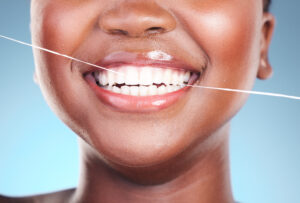Flossing is often recommended by dentists as a critical part of maintaining good oral health. However, some people may wonder if flossing can create gaps between their teeth. If you’ve ever noticed small spaces or feel like your teeth have shifted after starting a flossing routine, it’s natural to question whether flossing is to blame.
In this article, we’ll address common concerns related to flossing and gaps in teeth. We’ll discuss why gaps might form, whether flossing can loosen teeth, and how flossing can actually support the alignment of your teeth and gums. Let’s dive into the facts about flossing and oral health.
Does Flossing Create Gaps in Teeth?
The simple answer is: No, flossing does not create gaps between teeth. Flossing, when done correctly, removes food particles, plaque, and bacteria from between your teeth and along the gumline. It’s designed to help keep your mouth clean and your gums healthy. If you notice gaps or spaces between your teeth, it’s likely due to other factors, not flossing.

However, some people may mistake the feeling of “space” between their teeth after flossing as a sign that gaps are forming. This sensation is usually just the result of removing debris that was wedged between the teeth. Once the teeth are clean, it can feel like there’s more space, but that doesn’t mean a permanent gap has formed.
Why Are Gaps Forming Between My Teeth?
If you’ve noticed new gaps between your teeth, there could be several reasons for this. Flossing is unlikely to be the cause, but here are some factors that might lead to gaps between your teeth:
1. Gum Disease:
One of the most common causes of gaps forming between teeth is gum disease, also known as periodontal disease. When gum disease progresses, it can lead to the breakdown of the bone and tissue that support your teeth. As this happens, your teeth may shift, causing spaces or gaps to form. If you’re noticing gaps and haven’t been flossing regularly, gum disease might be a factor.
2. Teeth Shifting with Age:
As we age, it’s normal for our teeth to shift slightly. This shifting can sometimes cause small gaps to form between teeth. While this process is natural, regular flossing helps to keep plaque and bacteria from building up in these new spaces, which is essential for maintaining good oral health.
3. Tooth Loss or Extraction:
If you’ve had a tooth removed or lost a tooth due to decay or trauma, the surrounding teeth may shift to fill the empty space, which can result in gaps. In these cases, it’s important to talk to your dentist about solutions such as braces or dental implants to address the shifting.
4. Gum Recession:
Gum recession occurs when the gums pull back from the teeth, exposing more of the tooth or even the tooth root. This can make gaps appear more prominent. Gum recession is often caused by poor oral hygiene, aggressive brushing, or gum disease.
Do Teeth Get Loose After Flossing?
Many people worry that flossing too vigorously might loosen their teeth. Flossing does not make teeth loose. In fact, flossing can actually help to strengthen your teeth and gums by removing harmful plaque and bacteria that can cause gum disease, which is a major contributor to tooth loss.

If your teeth feel loose after flossing, it’s usually a sign that there’s already an underlying issue, such as gum disease or bone loss. When plaque builds up and hardens into tartar, it can lead to the breakdown of the structures that hold your teeth in place. Flossing can help prevent this from happening by keeping your teeth and gums healthy.
If you’re concerned about loose teeth, it’s important to visit your dentist for a checkup. They can assess the condition of your teeth and gums and recommend treatment if necessary.
Does Flossing Help Realign Teeth?
While flossing is great for keeping your teeth clean and your gums healthy, flossing alone cannot realign your teeth. If you have crooked or misaligned teeth, orthodontic treatments such as braces or clear aligners (like Invisalign) are typically needed to move your teeth into the correct position.
However, flossing plays an important role in preventing further shifting or damage to your teeth. By keeping your gums healthy and free of plaque, you’re reducing the risk of gum disease and bone loss, which can cause teeth to shift. Regular flossing, combined with professional cleanings and good oral care, can help maintain the alignment of your teeth after orthodontic treatment.
What Are the Benefits of Flossing?
Flossing offers several key benefits that go beyond just removing food particles from between your teeth. Here’s why it’s such an important part of your oral hygiene routine:
1. Prevents Gum Disease:
Flossing removes plaque from areas that your toothbrush can’t reach, such as between the teeth and below the gumline. By doing so, it helps prevent gum disease, which can lead to tooth loss and gaps between teeth if left untreated.
2. Reduces Bad Breath:
Plaque and food particles that aren’t removed can lead to bacteria growth, which causes bad breath. Flossing regularly helps keep your breath fresh by removing these particles and preventing bacterial buildup.
3. Prevents Cavities:
When plaque isn’t removed, it can eventually lead to the formation of cavities, especially in the tight spaces between teeth. Flossing helps protect these areas by removing the plaque before it can cause damage.
4. Protects Overall Health:
Oral health is closely linked to your overall health. Poor oral hygiene has been associated with a higher risk of heart disease, diabetes, and other conditions. By flossing daily, you’re not just protecting your teeth—you’re supporting your entire body’s well-being.
How to Floss Properly to Protect Your Teeth and Gums
Flossing may seem straightforward, but there’s a correct way to do it to ensure you’re getting the most benefit while avoiding damage to your gums. Here’s a step-by-step guide to flossing properly:
- Use About 18 Inches of Floss: Start by breaking off a piece of floss that’s about 18 inches long. Wrap most of the floss around one of your middle fingers, and then wrap the remaining floss around the middle finger of your other hand.
- Hold the Floss Tightly: Hold the floss tightly between your thumbs and forefingers, leaving about one to two inches of floss between your hands.
- Gently Guide the Floss: Carefully guide the floss between your teeth using a gentle back-and-forth motion. Avoid snapping the floss into your gums, as this can cause irritation.
- Curve the Floss Around Each Tooth: When the floss reaches the gumline, curve it into a “C” shape around each tooth and gently slide it under the gumline. Move the floss up and down to remove plaque from both sides of the tooth.
- Use a Clean Section for Each Tooth: As you move from tooth to tooth, use a clean section of floss to avoid spreading plaque and bacteria.
- Don’t Forget the Back Teeth: Make sure to floss the back teeth, even though they may be harder to reach.
What If Flossing Is Uncomfortable or Difficult?

For some people, flossing can be uncomfortable or difficult, especially if they have tight spaces between their teeth or sensitive gums. If traditional flossing isn’t working for you, there are alternatives that can make the process easier:
- Floss Picks: Floss picks are small, disposable tools that hold a short piece of floss on a handle. They’re easier to use for people who have trouble maneuvering regular floss.
- Water Flossers: Water flossers, such as Waterpik, use a stream of water to clean between teeth and along the gumline. They’re especially helpful for people with braces, dental work, or sensitive gums.
- Interdental Brushes: These tiny brushes are designed to clean between teeth and may be more comfortable for some people than traditional floss.
If flossing is uncomfortable, talk to your dentist about the best options for your needs. They can recommend the right tools and techniques to help you maintain healthy teeth and gums.
Conclusion: Flossing Supports Healthy Teeth—It Doesn’t Cause Gaps
In conclusion, flossing is an essential part of keeping your teeth and gums healthy. Flossing does not create gaps in teeth—in fact, it helps prevent the buildup of plaque and tartar that can lead to gum disease and tooth shifting. If you notice gaps forming, it’s likely due to other factors such as gum disease, tooth loss, or natural shifting with age.
Flossing helps protect your oral health by removing debris, preventing cavities, and reducing the risk of gum disease. If you haven’t made flossing a part of your daily routine yet, now is the perfect time to start! With the right technique and tools, you can support the health of your teeth and gums for years to come.

